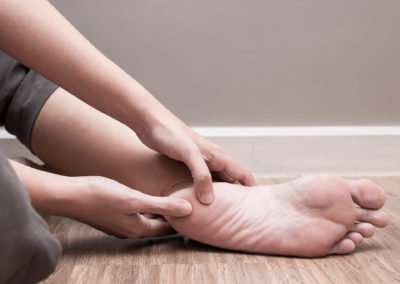Heel Pain (Plantar Fasciitis)
What is Plantar Fasciitis?
Heel pain can have many different presentations, the most common being a condition called Plantar Fasciitis. It’s characterised by pain in the heel or arch of the foot on first weight bearing in the morning and typically worsens toward the end of the day and it is often worse after periods of rest.
What Causes Plantar Fasciitis?
Plantar Fasciitis is a very common foot problem that can occur at any age and although often associated with sport often occurs after no history of high activity or trauma.
In most people there is no specific cause. The pain is simply there on first bearing weight in the morning. In some people there is a mechanical cause, i.e. the posture of their feet, or injury.
What are the Treatment Options for Plantar Fasciitis?
Treatment aims to address the cause of the condition and rest the affected area. Options include:
1. Supporting the arch of the foot to prevent the foot from “rolling in”
This is best achieved by wearing comfortable supportive shoes such as trainers and wearing insoles. These do not need to be made to measure but should have a good support to the arch, however custom orthotics are available through Mr Kannegieter. It is important that you wear the insoles all the time in sensible shoes in order for them to help.
2. Controlled stretching of the fascia and Achilles tendon
Mr. Kannegieter can show you some regular calf stretching exercises that you must do every day to help improve the condition. In most people this simple regime is enough to help significantly with the pain. If, however your symptoms persist the next stage would be to consider a steroid injection.
3. Steroid injection
This can bring about dramatic relief to your heel pain; however it is hard to predict how long the injection will last.
The injection of steroid which is a powerful anti-inflammatory into the heel reduces the inflammation and can reduce the pain. Numbing the heel before injecting the steroid significantly reduces the pain of injecting the steroid. It has been reported in the literature that the steroid can permanently thin the fat pad under the heel and this would be a major problem. We can inject the heel under ultrasound guidance to ensure more precise injections.
4. Electrocorpeal Shock-Wave Therapy (ESWT)
ESWT is a treatment that can be recommended for plantar fasciitis. The treatment consists of receiving shock waves to the painful area of the heel with the aim of reducing the inflammation and pain. The treatment usually takes around 10 minutes but requires between three and six sessions (one per week).
5. Immobilisation
If the pain persists, immobilising the heel might be required. This would be in a removable walker boot for up to 6 weeks.
6. Surgery
This is rarely needed. There are numerous surgical procedures but the basic aim is to detach a portion of the fascia from the heel bone. Should this become necessary Mr. Kannegieter will discuss this with you in detail.

Resources
Mr. Kannegieter has put together this useful PDF explaining treatment options for Plantar Fasciitis.
